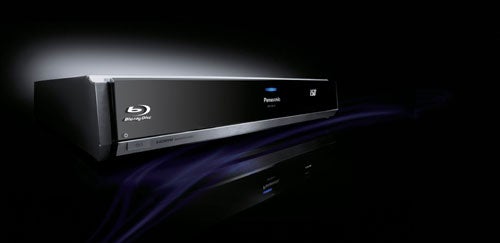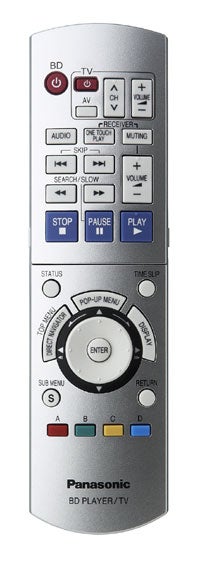Panasonic DMP-BD10 Blu-ray player Review
Panasonic DMP-BD10 Blu-ray player
Panasonic flies the Blu-ray flag with impressive results. You're gonna need deep pockets though!

Verdict
Key Specifications
- Review Price: £899.00
After what feels like a lifetime of waiting and speculating, Blu-ray and HD DVD players are finally available in Europe, giving us a chance to decide for ourselves which format to go for.
But after criticism of the initial movie releases and the lukewarm reception for Samsung’s BD-P1000 deck (which spectacularly fails to justify its £1,000 price tag) the Blu-ray camp hasn’t got off to a great start – a fact compounded by the price-slashing heroics of Toshiba, whose HD-E1 HD DVD deck delivers superb performance for a fraction of the Samsung’s price.
So as a result, it’s left to Panasonic’s DMP-BD10 to fly the flag for Blu-ray until the next wave of machines from the likes of LG and Philips hit the stores later this year. Its suggested retail price of £1,300 is likely to induce shivers among even the most committed early adopter (it’s almost three times more expensive than the HD-E1), but all new technology is expensive to begin with and you certainly get a lot more for your money than the underwhelming Samsung. Of course you can find the DMP-BD10 for around £900 online, but then Toshiba’s HD-E1 can be had online for as little as £334.

First, its solid build quality makes it look and feel like a more ‘high-end’ piece of kit, but it lacks the Samsung’s aesthetic pizzazz. Pull down the reflective front panel (which sadly isn’t motorised) and it reveals a stark, minimal fascia with only the key playback buttons to keep your fingers happy. The brushed aluminium adds a bit of refinement but overall we can’t help feel that the deck looks a bit dull. And at 85mm, it’s also very chunky, which could cause chaos under your TV if you’ve only got limited space.
But there’s a positive side to the deck’s portly physique – it enables Panasonic to pack the rear panel with sockets, an area where the DMP-BD10 steals a march on the BD-P1000 and the HD-E1.
Chief among these is the HDMI output, which should be your first port of call when connecting the player to your HD display. It’s worth noting that the socket is version 1.2 and not 1.3, which means that you don’t get the extra functionality afforded by the newer version.
Panasonic also provides an RGB-capable Scart output plus component, S-video and composite outputs. On the audio front, there are 7.1-channel analogue audio outputs, which reveals that the DMP-BD10 is fitted with a Dolby Digital Plus decoder (alongside decoders for Dolby Digital and DTS) and can therefore pipe this new 7.1 format to an amplifier with the relevant analogue inputs. Trouble is, Dolby Digital Plus isn’t a mandatory sound format for Blu-ray (it is for HD DVD) and few of the Blu-ray discs released so far actually use it. You’ll also find optical and coaxial digital audio outputs, which carry regular 5.1-channel Dolby Digital and DTS soundtracks.
So far so good? Not quite. One rather glaring omission from the rear panel is an Ethernet port, which means that the DMP-BD10 won’t be able to access online content once BD Live is up and running. We appreciate that Panasonic was trying to keep a cap on cost and that Ethernet isn’t mandatory for Blu-ray decks, but its omission is a little galling for the money – after all, it’s one of the format’s big selling points. It also means that firmware updates have to be made by playing a CD-R, either burned from the Web or provided by Panasonic.
Elsewhere however, there are loads of features to get your teeth into. The deck will play MPEG-2 and MPEG-4 (AVC or VC-1) and it’s the only Blu-ray deck to offer DVD-Audio playback.
The Panasonic can output native 1080p pictures found on most Blu-ray discs without relying on internal interlacing/deinterlacing, as is the case with the Samsung player. You can also upscale standard definition, 720p and 1080i material to 1080p.
There’s also a wealth of impressive-sounding technology working behind the scenes. Pixel Precision Progressive Processing for HD (try saying that after a few pints) generates the best-possible pictures from a Blu-ray disc by processing more than 15 billion pixels per second, and handling all de-interlacing and interlacing conversion where necessary. The deck also incorporates a 297MHz, 14-bit video DAC and a 192kHz/24-bit DAC for each of the eight audio channels.

As well as the aforementioned support for Dolby Digital Plus, it also decodes the uncompressed PCM soundtracks found on some discs (up to 7.1 channels), which can be transferred to a compatible amplifier via HDMI or played through the 7.1-channel analogue outputs. Dolby Digital Plus and DTS HD bitstreams can also be piped to a compatible amplifier via HDMI.
The DMP-BD10 does not support the lossless Dolby TrueHD and DTS HD Master Audio formats, though Panasonic will offer a firmware upgrade for Dolby TrueHD later this month. But given that the deck’s HDMI 1.2 output isn’t able to carry a Dolby TrueHD bitstream (only version 1.3 can do this), the upgrade will only allow the deck to transcode Dolby TrueHD into multichannel LPCM. With no HDMI v1.3-equipped amps on the market yet it’s not a big deal, but a bit of future-proofing would have been welcome.
Power up the DMP-BD10 and it takes a long time before it’s ready for action – around 50 seconds from opening the disc tray to an image appearing on screen. Chapter skipping is also slow, and navigating around a disc is quite cumbersome due to the poorly designed remote. It uses an odd rotating dial, which also acts as the left, right, up and down buttons when navigating a menu. The thing is, when you press down on the dial, nine times out of ten you accidentally turn it slightly, which activates the fast search mode – highly frustrating!
But once the disc is up and running, all frustration slowly melts away as you get drawn in by the DMP-BD10’s stunning picture quality. Viewed on a 50in 1,366 x 768 Panasonic plasma and a 1,920 x 1080 Sharp LCD, the Fantastic Four Blu-ray disc (1080p, MPEG-2) simply beggars belief, possessing an effortless clarity and vibrancy that adds another dimension to this visually striking superhero flick. Colours are deep and vivid, emphasising the movie’s comic-book visuals and giving the overall image true depth and solidity.
The centrepiece scene on the bridge is the best demonstration of the DMP-BD10’s picture prowess; minute details like the texture on Ben Grimm’s prosthetic suit are clearly visible, as is every piece of shattered glass and debris strewn across the road as the truck pile-drives into his body. Switching between 1080i and 1080p didn’t reveal a great deal of difference, as both look absolutely stunning, although 1080p seems marginally crisper and more fluid.

A Panasonic demo disc encoded in MPEG-4 also looks terrific despite the ropey content. Its uncompressed 7.1 PCM soundtrack gives us a chance to hear the format’s improved multi-channel audio capabilities and we weren’t disappointed by the rich and detailed sound quality. The DMP-BD10’s DVD-Audio playback is also excellent as the thumping rendition of Missy Elliott’s ‘Miss E…So Addictive’ attests.
The quality of upscaled DVDs is also of the highest order. It gives the Fantastic Four DVD a superb spit and polish in 720p and 1080i, making everything from facial close-ups to panoramic cityscapes look clean, sharp and natural (though it’s still no match for the Blu-ray version). Try though I might, I couldn’t see any traces of noise or artefacts resulting from the upscaling process either.
”’Verdict”’
From a performance perspective, there’s no denying that the DMP-BD10 is a sensational product and in terms of features it’s miles better than the Samsung BD-P1000. But there’s also no denying the fact that it’s wildly overpriced, costing nearly three times as much as the Toshiba HD-E1 HD DVD deck and twice as much as the step-up HD-XE1.
Having seen the picture quality of both the HD-E1 and the DMP-BD10, there isn’t £850 worth of difference in picture quality between the two (or even £550 at street prices), even taking into consideration the BD10’s 1080p capability. And when you consider that the Panasonic lacks the Ethernet connection found on the two HD DVD decks, then it becomes even harder to justify its lofty price tag.
With more Blu-ray decks being launched in 2007 and the PS3 just around the corner it’s far too early to predict who’ll win the fight to become the hi-def replacement for DVD, but one thing’s for sure: HD DVD has won round one…
Trusted Score
Score in detail
-
Performance 10
-
Features 8
-
Value 6

